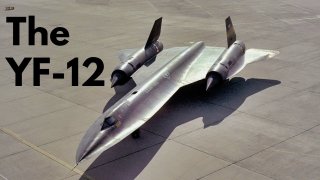Lockheed YF-12: The Mach 3 Interceptor Built to Fight Russia
The Lockheed YF-12, developed in the late 1950s and early 1960s, was a groundbreaking interceptor designed to counter Soviet bombers during the Cold War.
Summary: The Lockheed YF-12, developed in the late 1950s and early 1960s, was a groundbreaking interceptor designed to counter Soviet bombers during the Cold War.
-Capable of reaching speeds of Mach 3 and an altitude of 80,000 feet, the YF-12 set multiple records with its advanced technology.
-Despite its impressive performance, only three were built due to high costs and shifting priorities during the Vietnam War.
-One surviving YF-12 resides at the National Museum of the United States Air Force. Notably, the YF-12's covert sibling, the A-12 Oxcart, influenced the design of the legendary SR-71 Blackbird.
Unveiling the YF-12: The Cold War's Secret Interceptor
The Lockheed YF-12, developed in the late 1950s and early 1960s, was a groundbreaking interceptor designed to counter Soviet bombers during the Cold War. Capable of reaching speeds of Mach 3 and an altitude of 80,000 feet, the YF-12 set multiple records with its advanced technology.
Despite its impressive performance, only three were built due to high costs and shifting priorities during the Vietnam War. One surviving YF-12 resides at the National Museum of the United States Air Force. Notably, the YF-12's covert sibling, the A-12 Oxcart, influenced the design of the legendary SR-71 Blackbird.
The Cold War was a time when all major powers were always working on some secret project. The passing of time has seen increasingly more secrets of the era surface to the public eye.
One secret military project that has been out for a while is one of the most fascinating military aircraft ever conceived. The Lockheed YF-12 interceptor was a futuristic aircraft decades ahead of its time.
The Lockheed YF-12 Interceptor, Explained and What You Need to Know
Developed between the late 1950s and early 1960s by Lockheed and the U.S. Air Force, the YF-12 was a two-seat, high-altitude interceptor designed to take out Soviet supersonic bombers.
In terms of performance, the YF-12 had nearly unparalleled capabilities. Using two Pratt & Whitney J58 engines that could produce 32,000 lbs of thrust each, the YF-12 could reach speeds of Mach 3, had an operational ceiling of 80,000 feet, and a range of over 2,000 miles.
The YF-12 was equipped with a Hughes AN/ASG-18 fire control radar and could carry three Hughes AIM-47A air-to-air missiles.
Only three aircraft were built, but they managed to set several records in the relatively short time the YF-12 program was running. In 1965, for example, the YF-12 set both a speed record (2,070 miles per hour) and altitude record (80,257 feet) for the time. At some point, NASA worked with the Air Force on a program for supersonic cruise technology using the YF-12.
The program would never become operational. The high costs involved in its design and development, coupled with the ongoing war in Vietnam, meant that the YF-12 didn’t have the necessary support within the government to survive.
Out of the three YF-12s built, only one survives today and is located in the National Museum of the United States Air Force, Wright-Patterson Air Force Base, Ohio. The first aircraft was destroyed after a landing mishap, while the third aircraft was destroyed after an onboard fire forced the crew to abandon the aircraft and eject.
The YF-12’s Covert Sibling
One of the most interesting things about the YF-12 is that it had a sibling.
The A-12 Oxcart was a covert reconnaissance aircraft designed for and operated by the CIA. The aircraft was designed for missions over the Soviet Union and Communist China, using its extremely fast speeds and its ability to fly at very high altitudes. Unlike the YF-12, the A-12 Oxcart was a single-seat aircraft.
When the White House decided to reveal the existence of the YF-12 interceptor in the mid-1960s, it did so in part to cover for the A-12 Oxcart. Both aircraft influenced the design of the SR-71 Blackbird reconnaissance aircraft, which remains one of the fastest and most capable aircraft to ever take to the skies.
About the Author
Stavros Atlamazoglou is a seasoned defense journalist specializing in special operations and a Hellenic Army veteran (national service with the 575th Marine Battalion and Army HQ). He holds a BA from the Johns Hopkins University and an MA from the Johns Hopkins’ School of Advanced International Studies (SAIS). His work has been featured in Business Insider, Sandboxx, and SOFREP.


